By Bill Adkins and Andy Soccodato
Water supply operations in the rural setting comprise some of the most challenging scenarios that firefighters face. These challenges are magnified when companies are not equipped with the necessary tools to efficiently operate in the rural environment.
This article continues from Part 1 and highlights some of the most important pieces of equipment that should be on every rural engine company to seamlessly perform water supply functions at a rural fire incident.
Some of the equipment mentioned in this article is likely equipment your engine company is already carrying. Other pieces may be items that your department considers budgeting for and purchasing in the future. Regardless, each item listed allows the rural pump operator to reliably perform his duties on the rural fireground regardless of whether the item costs several thousand dollars or only a few dollars. You can add some of these items to your apparatus as soon as you finish reading this article; however, you may have to consider other items as part of your next apparatus purchase. Consider the items discussed as essential pieces companies that routinely operate as part of a rural water supply operation carry.
MANIFOLDS
Manifolds are gated valves that can control water supply to multiple lines (photo 1). Another name for a manifold is a water thief. Many times, a manifold acts as an extension of the pump panel hundreds of feet away from the apparatus. One example is at a tanker static water source fill site, where the drafting apparatus may end up several feet away from where the tankers can access (photo 2). The drafting apparatus can lay a supply line with a manifold at the end from the fill site to the drafting site. When tankers arrive at the fill site, there will be water to the manifold from the drafting apparatus. All the firefighter at the manifold needs to do is open the valve to refill the tanker (photo 3).
Manifolds also provide the ability to supply multiple attack lines on the fireground. There are times when the first-due apparatus must park several hundred feet away from the incident. A horizontal standpipe may need to be used. For example, if using a horizontal standpipe, a manifold can be placed at the end of 2½- or 3-inch hose to supply multiple attack lines several hundred feet away from the attack apparatus. A firefighter should remain at the manifold to ensure valves are not shut accidentally.
Manufacturers provide various types and sizes of manifolds—from 2½ to 2½, Storz to Storz, Storz to 2½, Storz to Storz and 2 ½, clappered, or gated valves and the list goes on. Match the flow capabilities with the flow you want to sustain. You will need to have a manifold to support not only your supply hose but your mutual-aid companies as well.
CLAPPERED SIAMESE
Like manifolds, clappered siamese valves come in many configurations. A clappered siamese combines multiple lines into one line. This allows different lines to be added without flow interruption. These valves are popular for water supply operations. When purchasing, order what works best not only for your department but for your mutual-aid departments.
When referring to a sustained rural water supply, use a relay of some type. This prevents loss of water pressure to the interior crew when attempting a draft from a static water source. It also provides two complete engines along with two complete pumps in the event that one has some type of mechanical failure.
One type of relay in rural communities is the rural hitch. When operating in the rural hitch, a clappered siamese serves as a great tool to aid in relay pumping to the first-due apparatus (photo 4). Sometimes the rural hitch may involve more than one apparatus moving water to the first-due apparatus. A clappered siamese valve placed at the end of the water supply allows two or more apparatus (simultaneously) to flow water to the first-due apparatus. This allows little to no interruption in water supply at the fireground while crews establish some type of sustained water supply. Unlike manifolds, the clappered siamese does not require a firefighter to stay at the device to operate. The country has a known shortage of staffing. Leaving a firefighter at a manifold may not be practical.
CHAFFING BLOCK
One of the simpler, yet vitally important, pieces of equipment that every rural engine company should carry is the chaffing block. This homemade tool consists of nothing more than a ¾-inch piece of plywood cut to effectively prop up hose or hard sleeve. The dimensions of the chaffing block are not exact, and firefighters should cut them to meet their specific needs and apparatus compartments. While there are a variety of ways this tool can be used on the fireground, it is most beneficial when a single firefighter is attempting to connect two pieces of 6-inch hard sleeve together.
Any firefighter who has attempted to connect two lengths of hard sleeve together by himself knows that this task is nearly impossible because of the size and rigidity of the hard sleeve. To do this singlehandedly, the operator should rest the male end of one of the hard sleeves on the chaffing block so that the male threads are suspended in the air (photo 5). The operator should then place the female end of the other section between his legs and clamp onto it using his shins. This will allow his hands to be free to guide the male coupling toward the female coupling and thread the two together (photo 6). If more than two sections need to be connected, the solo operator continues this process using the chaffing block as the “second set of hands.”
1 A manifold at a fill site being used to fill tankers. (Photos by authors.)
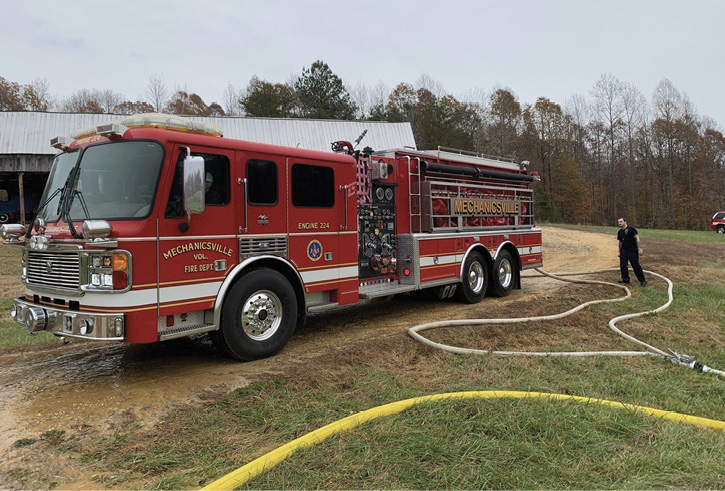
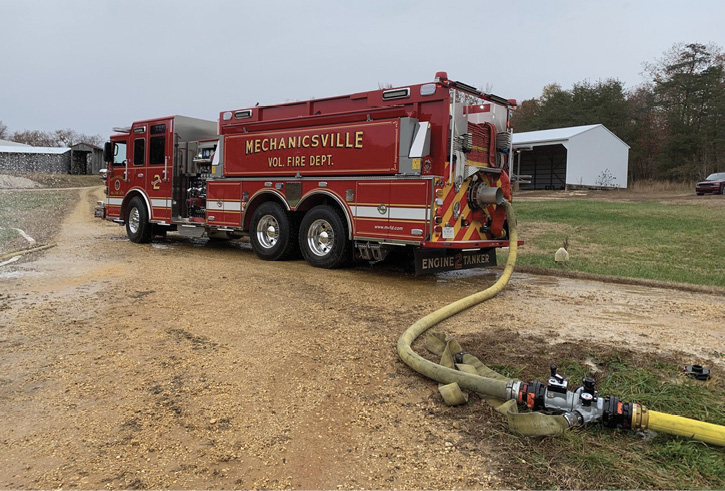
2 A large-diameter water thief being used at a fill site to fill tankers.
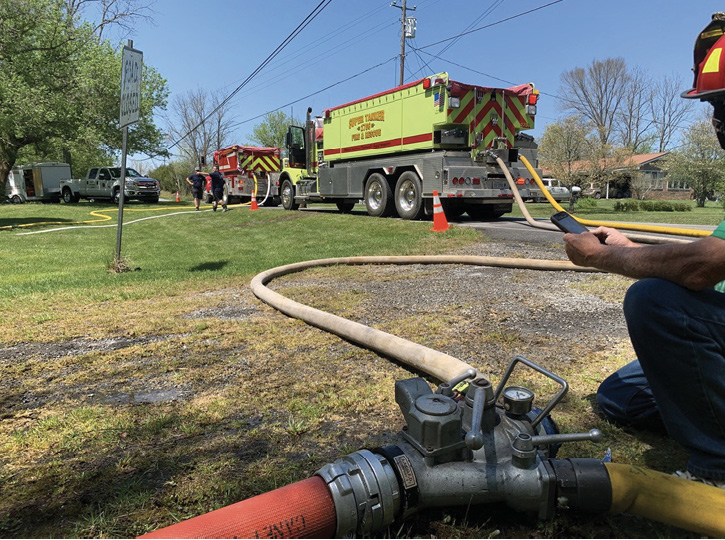
3 The firefighter at the manifold controls the flow of water into the tanker during the filling process.
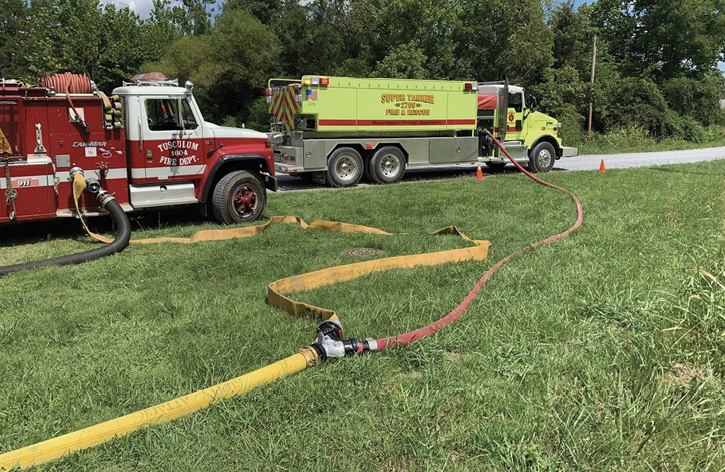
4 A clappered siamese used in the rural hitch. Tanker 2706 feeds water to an attack engine while Engine 1604 sets up to feed additional water to the attack engine.
LADDERS AND TARPS/SALVAGE COVERS
A ladder is another common tool that is likely already on your engine company. While the lengths and styles of your ladders may vary, it is important to recognize that ladders are primarily used on the horizontal plane during rural water supply operations. Common uses for ground ladders during rural water operations include bridging jet siphon lines between dump tanks, propping up a barrel strainer in a static body of water (photo 7), and use during a damming operation (photo 8).
Bridging and damming operations, in particular, can use multiple ground ladders depending on the number of dump tanks deployed and the width of the source being dammed. Firefighters should be mindful of this and recognize that ground ladders may also be a limited resource on the rural fire scene. This is one of the advantages of carrying ground ladders on mobile water shuttle apparatus if possible. Not only can these apparatus bring additional hard sleeves to both the fill and dump sites, but they can also drop off additional ground ladders at these sites depending on the operation.
Tarps or salvage covers are also an invaluable tool on the rural fireground. During rural water supply operations, they are most commonly used to serve as barriers between the ground and a dump tank or in conjunction with a ground ladder for a damming operation. To be most effective, each rural engine and mobile water shuttle apparatus should carry at least two tarps for these operations. Organizations should consider their dump tank dimensions when determining what size tarp to purchase for barrier protection.
For departments that routinely perform damming operations, it is critically important that the organizations consider purchasing thicker vinyl salvage covers for these operations. The thicker material will be more resistant to wear and perform better during a damming operation. When lighter weight utility tarps are used, there is a high probability that the water pressure exerted against the dam will cause the material to tear and the dam to fail catastrophically. The same size tarps used for dump tank barrier protection can also be used to sufficiently wrap a ground ladder for a damming operation.
WATER EDUCTOR
Accessing distant water sources is often one of the biggest challenges encountered during a rural water supply operation. In many instances, fire departments are forced to forego these sources simply because they are unable to reach them. The TurboDarft water eductor solves this problem by using soft suction hose, the device itself, and venturi physics (photo 9). In its traditional configuration, the TurboDraft is placed into the water source with a 2½- or 3-inch line coming from a discharge on the pumper and connected to the device’s inlet. A 5-inch supply line is then connected to the outlet of the eductor and run to the pump intake on the engine. The pumper will then discharge a portion of its tank water into the line feeding the device. This will cause a massive venturi that draws more water back to the pumper through the 5-inch supply line.
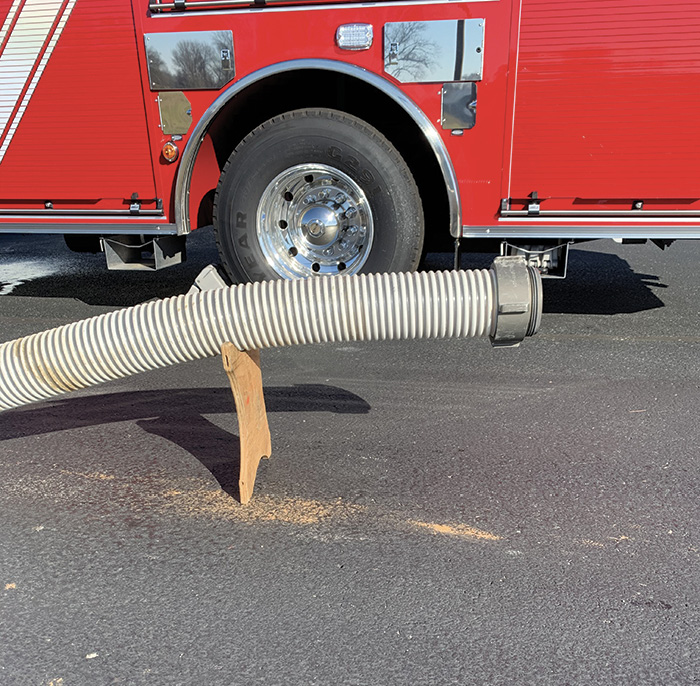
5 Using a chaffing block to support the male end of the hard sleeve for one firefighter to connect two sections together.
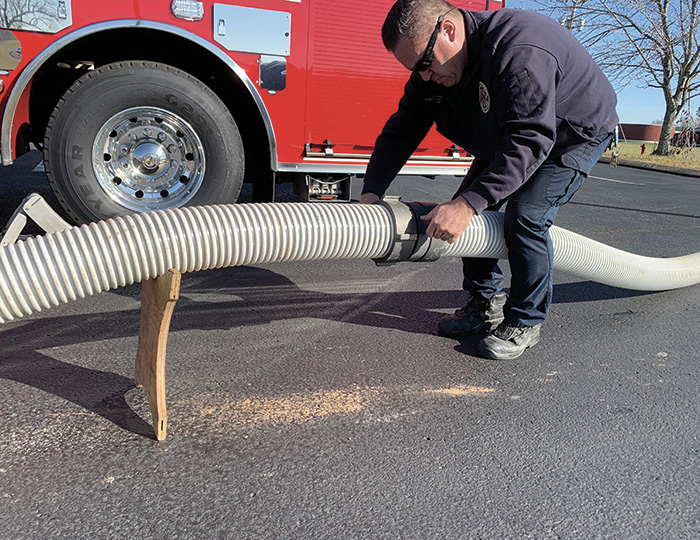
6 A single firefighter using a chaffing block to connect two 10-foot sections of hard sleeve together.
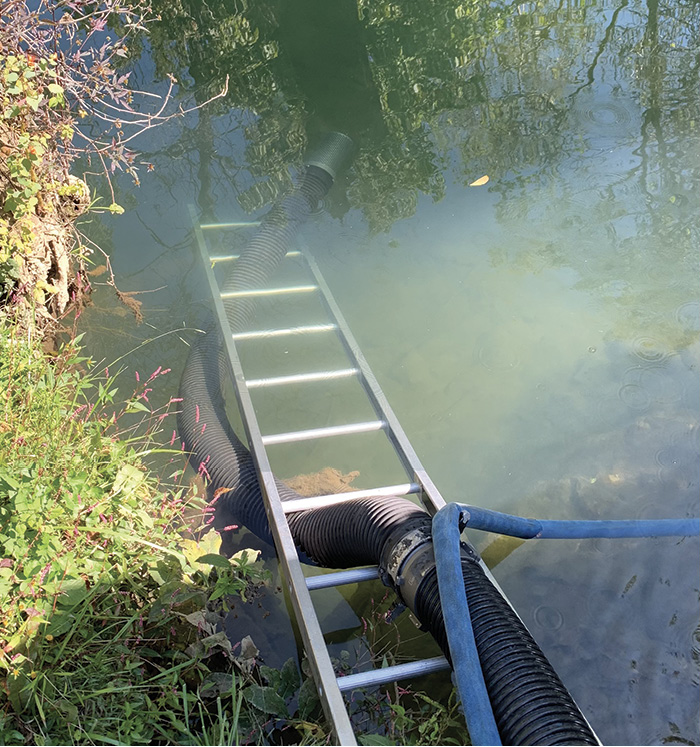
7 A ground ladder being used to keep a barrel strainer from resting on the bottom of this creek.
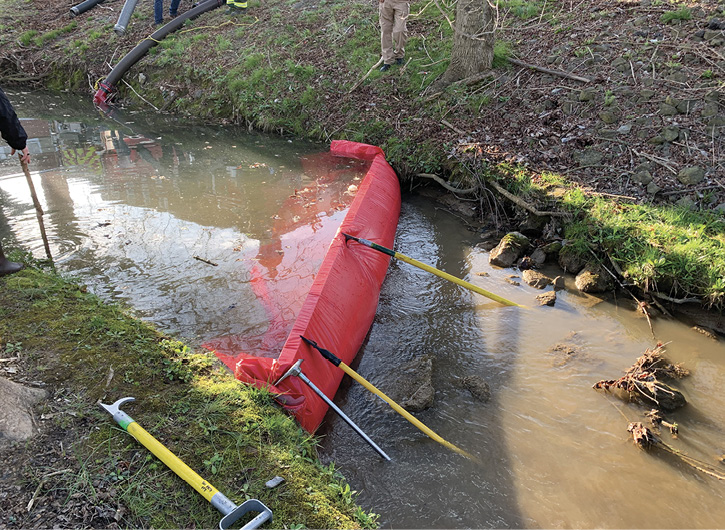
8 Ground ladders and tarps are essential for performing a damming operation.
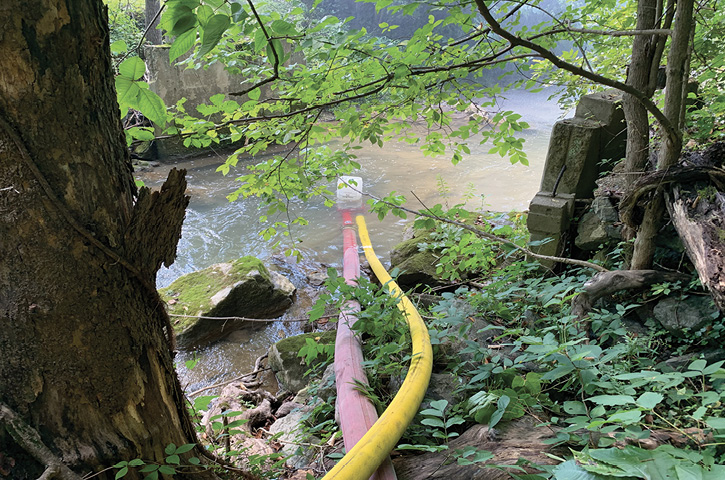
9 The TurboDraft allows rural engine companies to access water from sources they otherwise would ignore.
The major advantage of the TurboDraft is that in its traditional configuration, the pumper can be up to 100 feet away from the water source and achieve roughly a 550-gallon-per-minute (gpm) usable flow rate. If this distance is shortened to 50 feet, the usable flow rate increases to roughly 700 gpm. One of the key pillars to a successful TurboDraft operation is that the hose connected to the return side of the device must be at least 5 inches in diameter. The line should also be as short as possible to maximize the flow. For this reason, apparatus that carry these tools should also be carrying two 25-foot lengths and one 50-foot length of 5-inch hose. This will allow the operator to access water that is either 100 feet, 75 feet, 50 feet, or 25 feet from the apparatus quickly and efficiently.
It is important to recognize that the TurboDraft is not a replacement for carrying extra sections of hard sleeve on the rural pumper. On the contrary, this tool is intended to allow rural pump operators to rapidly establish water from a distant source to begin the operation. For example, consider how long it would take a single operator to remove five 10-foot sections of 6-inch hard sleeve from the apparatus, connect it together, place it in the water, and achieve a prime. The same operator can deploy a TurboDraft and achieve a water supply in a fraction of the time it takes for the traditional drafting operation to be placed in service.
Firefighters must remember that the flow through the TurboDraft operation will be less than through a traditional drafting operation. In the scenario outlined above, if the flow demands are not being met, the operator can certainly begin connecting hard sleeve together and prepare to transition over to a conventional draft while the TurboDraft operation provides the initial water for the operation.
PREPLANNING RURAL FIRES
It’s extremely important that fire crews have some type of plan before arriving at the scene of a fire. All incidents are slightly different, but there should be some type of baseline to start with. Firefighters need to know what is expected of them prior to arriving on scene.
Seating assignments, even in the rural setting, prove to harness firefighters to work on jobs that need to be completed on every fire. Things like pulling the proper attack line, setting up the water supply, and completely sizing up the entire incident before making entry are just a few examples. This will prevent micromanaging while on scene. Firefighters will be expected to do the job based on their seating assignment without the need of a supervisor walking them through it.
Have a set of plays as if you were on a sports team. What jobs need to be completed on an interior attack? What jobs need to be done when it is a defensive fire? Discuss these types of scenarios with your members and make sure they are clear on these jobs when at training. Then practice these scenarios prior to the 911 calls.
Departments should also have a list of high-hazard occupancies in their areas. Each and every member should be aware of these occupancies and a walk-through (with permission) should be conducted annually. Preplanning these high-hazard areas gives your team a head start on critical tasks to be completed on arrival. Learning the layout of a building when it is in normal operation helps firefighters understand where they are in a time when there may be little to zero visibility.
Another preplan firefighters should consider has the options of water sources in your first-due area. One would be amazed at how many departments pass multiple water sources on their way to a hydrant miles away. Train, with all your members on the department, to know these sources. Ask all members if they know of other water sources not mentioned. Even the youngest firefighter may know of a water source that the most senior member did not.
BILL ADKINS is a captain with the Loveland-Symmes (OH) Fire Department Training Division/Maintenance Division.
ANDY SOCCODATO has served in the fire service for the past 17 years. He spent nine years of his career as a firefighter and driver/operator for the Charlottesville (VA) Fire Department. He is a full-time fire instructor II at the Tennessee State Fire Academy, where he oversees the driver/pump and aerial programs. Soccodato is the owner of The Water Thieves, LLC, which specializes in delivering street smart driver/pump operator courses. He is on the Editorial Advisory Board for Fire Apparatus & Emergency Equipment.

